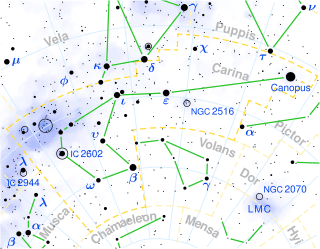HD 96919
HD 96919, also known by its Bayer designation of z2 Carinae and the variable star designation of V371 Carinae, is a blue supergiant star in the constellation Carina. It lies near the Carina Nebula and at a comparable distance.
 | |
| Observation data Epoch J2000 Equinox J2000 | |
|---|---|
| Constellation | Carina |
| Right ascension | 11h 08m 33.99848s[1] |
| Declination | −61° 56′ 49.8316″[1] |
| Apparent magnitude (V) | 5.19[2] (5.12 - 5.19[3]) |
| Characteristics | |
| Spectral type | B9 Iae[4] |
| U−B color index | −0.46[2] |
| B−V color index | +0.23[2] |
| Variable type | α Cyg[3] |
| Astrometry | |
| Radial velocity (Rv) | −22.4 ± 2[5] km/s |
| Proper motion (μ) | RA: −5.78[1] mas/yr Dec.: 1.74[1] mas/yr |
| Parallax (π) | 0.23 ± 0.25[1] mas |
| Distance | 1,920[6] pc |
| Absolute magnitude (MV) | −7.0[6] |
| Details | |
| Mass | 23[4] M☉ |
| Radius | 141[4] R☉ |
| Luminosity | 105,000[7] L☉ |
| Surface gravity (log g) | 1.50[4] cgs |
| Temperature | 12,500[7] K |
| Rotational velocity (v sin i) | 60[4] km/s |
| Other designations | |
| Database references | |
| SIMBAD | data |
V371 Car is an α Cyg variable, erratically pulsating and changing brightness by a few hundredths of a magnitude. Periods of 10–80 days have been identified.[7] It shows unusual emission lines in its spectrum, and high-velocity absorption (HVA) events, temporary spectral features that are thought to indicate localised regions of enhanced mass loss.[9]
HD 96919 is a B9 supergiant, possibly located 6,000 light-years from Earth. It is considered to be a post-red supergiant star, either evolving towards a Wolf–Rayet star or on a blue loop before returning to a cooler temperature.[7]
References
- Van Leeuwen, F. (2007). "Validation of the new Hipparcos reduction". Astronomy and Astrophysics. 474 (2): 653. arXiv:0708.1752. Bibcode:2007A&A...474..653V. doi:10.1051/0004-6361:20078357.
- Ducati, J. R. (2002). "VizieR Online Data Catalog: Catalogue of Stellar Photometry in Johnson's 11-color system". CDS/ADC Collection of Electronic Catalogues. 2237: 0. Bibcode:2002yCat.2237....0D.
- Samus, N. N.; Durlevich, O. V.; et al. (2009). "VizieR Online Data Catalog: General Catalogue of Variable Stars (Samus+ 2007-2013)". VizieR On-line Data Catalog: B/gcvs. Originally Published in: 2009yCat....102025S. 1. Bibcode:2009yCat....102025S.
- Kaufer, A.; Stahl, O.; Wolf, B.; Gaeng, T.; Gummersbach, C. A.; Kovacs, J.; Mandel, H.; Szeifert, T. (1996). "Long-term spectroscopic monitoring of BA-type supergiants. I. Halpha_ line-profile variability". Astronomy and Astrophysics. 305: 887. Bibcode:1996A&A...305..887K.
- Wilson, Ralph Elmer (1953). "General catalogue of stellar radial velocities". Washington. Bibcode:1953GCRV..C......0W.
- Kaltcheva, N.; Scorcio, M. (2010). "The Carina spiral feature: Strömgren-β photometry approach. II. Distances and space distribution of the O and B stars". Astronomy and Astrophysics. 514: A59. Bibcode:2010A&A...514A..59K. doi:10.1051/0004-6361/200913399.
- Saio, Hideyuki; Georgy, Cyril; Meynet, Georges (2013). "Evolution of blue supergiants and α Cygni variables: Puzzling CNO surface abundances". Monthly Notices of the Royal Astronomical Society. 433 (2): 1246. arXiv:1305.2474. Bibcode:2013MNRAS.433.1246S. doi:10.1093/mnras/stt796.
- Gould, Benjamin Apthorp (1879). "Brightness and position of every star, down to the seventh magnitude, within one hundred degrees of the South Pole". Resultados del Observatorio Nacional Argentino. 1. Bibcode:1879RNAO....1....1G.
- Kaufer, A.; Stahl, O.; Wolf, B.; Gaeng, T.; Gummersbach, C. A.; Jankovics, I.; Kovacs, J.; Mandel, H.; Peitz, J.; Rivinius, T.; Szeifert, T. (1996). "Long-term spectroscopic monitoring of BA-type supergiants. II. High-velocity absorptions in βOri and HD96919". Astronomy and Astrophysics. 314: 599. Bibcode:1996A&A...314..599K.